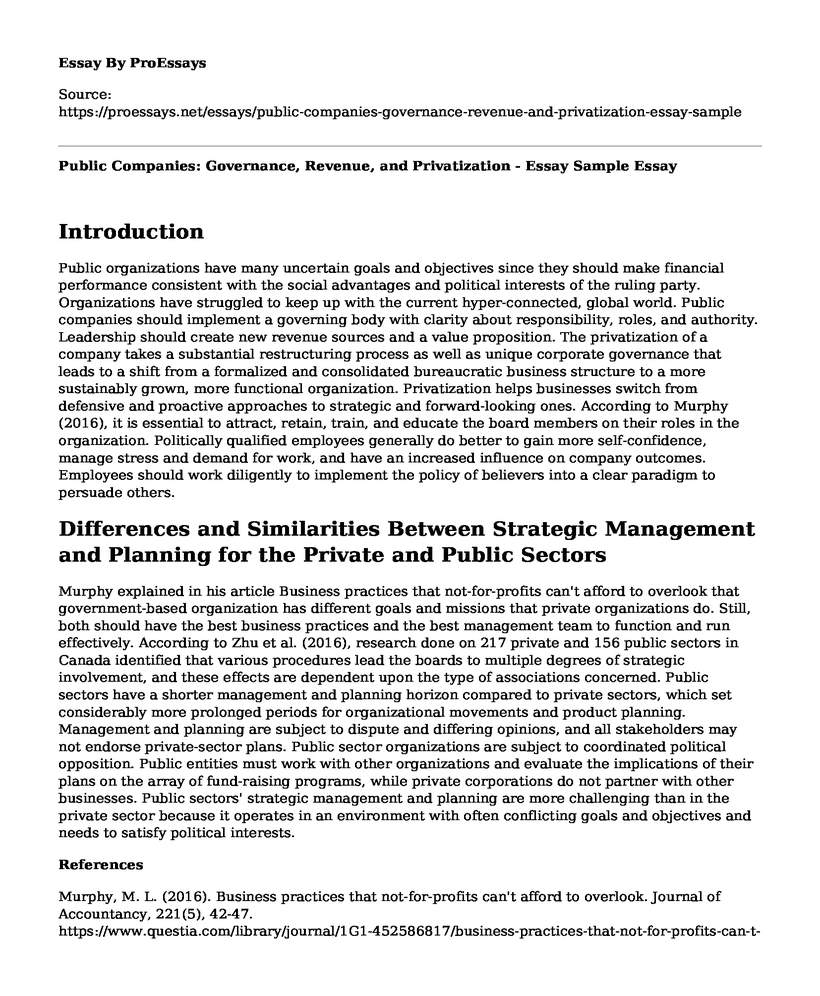Introduction
Public organizations have many uncertain goals and objectives since they should make financial performance consistent with the social advantages and political interests of the ruling party. Organizations have struggled to keep up with the current hyper-connected, global world. Public companies should implement a governing body with clarity about responsibility, roles, and authority. Leadership should create new revenue sources and a value proposition. The privatization of a company takes a substantial restructuring process as well as unique corporate governance that leads to a shift from a formalized and consolidated bureaucratic business structure to a more sustainably grown, more functional organization. Privatization helps businesses switch from defensive and proactive approaches to strategic and forward-looking ones. According to Murphy (2016), it is essential to attract, retain, train, and educate the board members on their roles in the organization. Politically qualified employees generally do better to gain more self-confidence, manage stress and demand for work, and have an increased influence on company outcomes. Employees should work diligently to implement the policy of believers into a clear paradigm to persuade others.
Differences and Similarities Between Strategic Management and Planning for the Private and Public Sectors
Murphy explained in his article Business practices that not-for-profits can't afford to overlook that government-based organization has different goals and missions that private organizations do. Still, both should have the best business practices and the best management team to function and run effectively. According to Zhu et al. (2016), research done on 217 private and 156 public sectors in Canada identified that various procedures lead the boards to multiple degrees of strategic involvement, and these effects are dependent upon the type of associations concerned. Public sectors have a shorter management and planning horizon compared to private sectors, which set considerably more prolonged periods for organizational movements and product planning. Management and planning are subject to dispute and differing opinions, and all stakeholders may not endorse private-sector plans. Public sector organizations are subject to coordinated political opposition. Public entities must work with other organizations and evaluate the implications of their plans on the array of fund-raising programs, while private corporations do not partner with other businesses. Public sectors' strategic management and planning are more challenging than in the private sector because it operates in an environment with often conflicting goals and objectives and needs to satisfy political interests.
References
Murphy, M. L. (2016). Business practices that not-for-profits can't afford to overlook. Journal of Accountancy, 221(5), 42-47. https://www.questia.com/library/journal/1G1-452586817/business-practices-that-not-for-profits-can-t-afford
Zhu, H., Wang, P., & Bart, C. (2016). Board processes, board strategic involvement, and organizational performance in for-profit and non-profit organizations. Journal of Business Ethics, 136(2), 311-328. https://link.springer.com/article/10.1007/s10551-014-2512-1
Cite this page
Public Companies: Governance, Revenue, and Privatization - Essay Sample. (2023, Aug 28). Retrieved from https://proessays.net/essays/public-companies-governance-revenue-and-privatization-essay-sample
If you are the original author of this essay and no longer wish to have it published on the ProEssays website, please click below to request its removal:
- Move Baladna Company That Qatar Brand to UK Foreign Market
- Lebanese Apples Inc. New Market Entry Paper Example
- Essay Sample on Consumer Protection: Safeguarding Rights & Fairness in Trade
- Essay Sample on Organizational Principle: Sowing Bountifully and Patience
- Paper Example on 4 Rational Selling Premises for Strategic Communications
- Successful Org Design: CDS Achieves Goals With Strategy, Ops, HR & Leadership - Essay Sample
- Paper Example on IAWP: Strengthening Women in Policing since 1915







